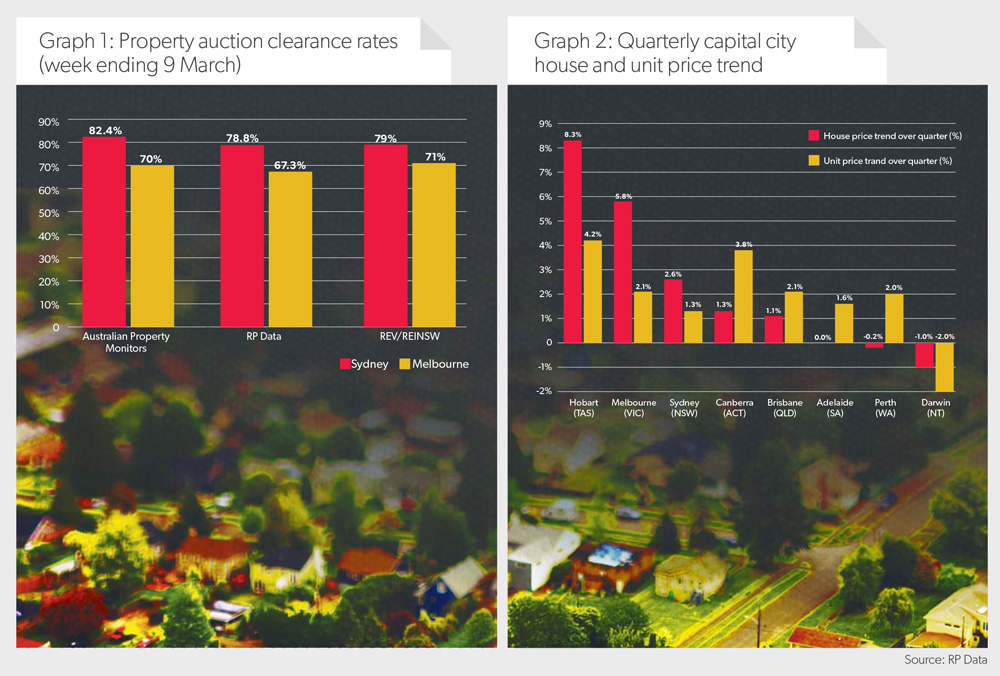The residential real estate market took a breather in February, bringing quarterly growth to 2.6 per cent.
RP Data recorded February’s market growth rate at 0 per cent, indicating the first signs of an easing in growth rates for the year. The statistic means the market moved 2.6 per cent in the quarter ending February for a 9.5 per cent annual growth across the eight capital cities. The start of the year is traditionally associated with a slowdown of activity in the property market as it builds towards Easter.
Monetary policy continues to assist the property market, with the Reserve Bank of Australia (RBA) meeting on 4 March and deciding to leave the overnight cash rate at a 50-plus-year record low of 2.50 per cent. The statement produced by the RBA mentions the policy as remaining accommodative, as interest rates remain low and credit growth gradually improves. The housing market is now 9.5 per cent over its previous peak and 13.2 per cent over its previous trough in mid-2012. Out of the capital cities, Sydney remains an outlier at 12.6 per cent over its previous market peak, with Brisbane, Darwin and Hobart showing substantial potential to improve on an 8 per cent to 9 per cent negative difference from the previous market peak.
Key metrics about the Australian and international economies were recently released by the major statistical agencies. Australia’s gross domestic product growth rate for 2013 was 2.8 per cent, according to the Australian Bureau of Statistics (ABS), beating expectations placing the figure at 2.6 per cent. The fourth quarter gain was 0.8 per cent, higher than the 0.6 per cent figure for the third quarter. Jobs data was mixed, with 47,300 jobs added in February (80,500 full-time jobs added), but the unemployment rate steady at 6 per cent. Inflation remained at 2.7 per cent, while the Australian dollar was resilient at the 90-cent US dollar frontier, given positive growth figures. Consumer sentiment, however, fell under 100 index points and is now at the lowest point since May 2013.
New dwelling building approvals, as tracked by the ABS, showed a 6.8 per cent change in January. This brought the trend up to 1.3 per cent. Dwelling approvals are now 28.4 per cent higher than at the same time in 2013. New home sales tracked by the Housing Industry Association also recorded a minor improvement at 0.5 per cent for January. New home sales were up 17 per cent as compared to the same time last year. The ABS said the value of housing finance commitments was down marginally in January, but up 1.2 per cent in trend terms. The Australian housing market has started the year on a good footing, but there remains uncertainty surrounding the direction of growth.
Residential vacancy rates
While some have raised questions about developments creating potential for excess supply in the inner-city market in the short term and diluting growth rates, property investment decisions should be dictated by long-term factors. While approvals are trending over 30 per cent higher than the past year, development construction continues to be slow and is making up for many years of substantial undersupply. Future Estate believes current levels of construction are unlikely to cause a risk of oversupply and are simply the resumption of more positive market conditions, and a normal response to low interest rates and a stable economic environment.

Auction clearance rates
Auction clearance rates across the major capital cities continue to record very strong figures. Sydney’s auction clearance was above 80 per cent as recorded by Australian Property Monitors (APM), but around 79 per cent as assessed by RP Data and the Real Estate Institute of New South Wales. Sydney’s median house price is now $700,000 and the market has grown by 1.7 per cent this year. Melbourne’s auctions on the 9 March weekend were clouded by the Labour Day long weekend, therefore recording fewer auctions than normal. Auction clearance rates were measured at about 70 per cent across the three data providers APM, RP Data and the Real Estate Institute of Victoria. Melbourne houses have a median price of $550,000 and have already grown 3.4 per cent this year as the capital city rapidly emerges from declines last year.
Capital cities
Australian capital cities returned 14.2 per cent to investors in the year ending February 2014. This was 0.3 per cent lower than the figure the previous month, yet still indicates a very robust return over the year. The return figure aggregates the potential rental and capital gains value made by investors in the past year. Sydney, having grown 0.8 per cent in February, posted an annual return figure of 19 per cent. Melbourne, which recorded a slight 0.2 per cent contraction in February, had an annual return figure of 14 per cent. Melbourne dwelling values grew by 9.9 per cent annually, as recorded by RP Data. Rental returns were 3.9 per cent and 4.7 per cent from houses and units, respectively, in Sydney. Melbourne’s rental returns were 3.4 per cent and 4.2 per cent from houses and units, respectively, slightly up from the previous month’s recorded results. Other notable rental returns were in Darwin, which was still recording 6 per cent-plus returns from its dwellings, and Hobart, which posted a 5.2 per cent return from its houses and units. Hobart has experienced strong growth this year, at 3.4 per cent, after its continued property market decline last year.



